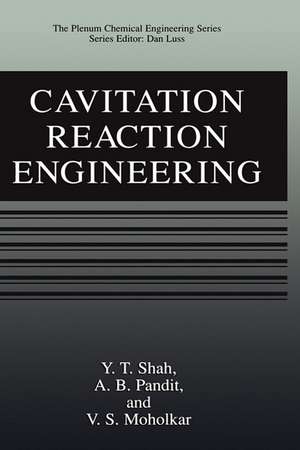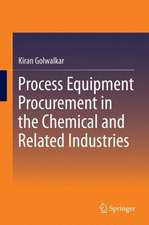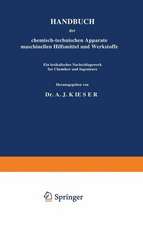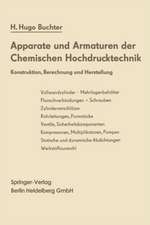Cavitation Reaction Engineering: The Plenum Chemical Engineering Series
Autor Y.T. Shah, A.B. Pandit, V.S. Moholkaren Limba Engleză Hardback – 30 sep 1999
| Toate formatele și edițiile | Preț | Express |
|---|---|---|
| Paperback (1) | 1819.59 lei 6-8 săpt. | |
| Springer Us – 13 iul 2013 | 1819.59 lei 6-8 săpt. | |
| Hardback (1) | 1825.75 lei 6-8 săpt. | |
| Springer Us – 30 sep 1999 | 1825.75 lei 6-8 săpt. |
Preț: 1825.75 lei
Preț vechi: 2226.53 lei
-18% Nou
Puncte Express: 2739
Preț estimativ în valută:
349.40€ • 379.40$ • 293.49£
349.40€ • 379.40$ • 293.49£
Carte tipărită la comandă
Livrare economică 22 aprilie-06 mai
Preluare comenzi: 021 569.72.76
Specificații
ISBN-13: 9780306461415
ISBN-10: 0306461412
Pagini: 352
Ilustrații: XIX, 352 p.
Dimensiuni: 155 x 235 x 22 mm
Greutate: 0.7 kg
Ediția:1999
Editura: Springer Us
Colecția Springer
Seria The Plenum Chemical Engineering Series
Locul publicării:New York, NY, United States
ISBN-10: 0306461412
Pagini: 352
Ilustrații: XIX, 352 p.
Dimensiuni: 155 x 235 x 22 mm
Greutate: 0.7 kg
Ediția:1999
Editura: Springer Us
Colecția Springer
Seria The Plenum Chemical Engineering Series
Locul publicării:New York, NY, United States
Public țintă
ResearchCuprins
1. Sources and Types of Cavitation.- 1.1. Introduction.- 1.2. Hydrodynamic Cavitation.- 1.3. Acoustic Cavitation.- 1.4. Optic and Particle Cavitation.- 2. Cavitation Bubble Dynamics.- 2.1. Introduction.- 2.2. Bubble Dynamics.- 2.3. Cluster Dynamics.- 2.4. Heat and Mass Transfer Effects in Cavitation.- 2.5. Concluding Remarks.- 3. Factors Affecting Cavitation Behavior.- 3.1. Introduction.- 3.2. Factors Affecting Cavity Behavior in Hydrodynamic Cavitation.- 3.3. Factors Affecting Cavity Behavior in Acoustic Cavitation.- 3.4. Factors Affecting Optical Cavitation.- 3.5. Factors Affecting Cavity Cluster Behavior in Hydrodynamic Cavitation.- 3.6. Factors Affecting Cavity Cluster Behavior in Acoustic Cavitation.- 3.7. Concluding Remarks.- 4. Gas-Liquid Cavitation Chemistry.- 4.1. Introduction.- 4.2. Mechanisms for Cavitation Reaction.- 4.3. Factors Affecting Cavitation Chemistry.- 4.4. Inorganic and Organic Cavitation Reactions.- 4.5. Depolymerization and Repolymerization Reactions.- 4.6. Ultrasound and Homogeneous Oxidation.- 4.7. Ultrasound and Liquid-Liquid Phase-Transfer Reactions.- 5. Gas-Liquid-Solid Cavitation Chemistry.- 5.1. Introduction.- 5.2. General Effects of Ultrasound on Gas-Liquid-Solid Reactions.- 5.3. Specific Role of Ultrasound on Gas-Liquid-Solid Reactions.- 5.4. Case Studies.- 6. Cavitation Reactors.- 6.1. Introduction.- 6.2. Hydrodynamic Cavitation Reactors.- 6.3. Acoustic Cavitation Reactors.- 6.4. Laser Cavitation Reactors.- 6.5. Some Additional Considerations for Flow Reactors.- 6.6. Health and Safety Aspects of Laboratory Reactors.- 6.7. Integration of Cavitation into Existing Scaled-Up Processes.- 6.8. Concluding Remarks.- 7. Models for Cavitation Reactors.- 7.1. Introduction.- 7.2. General Considerations for a Gas-Liquid Cavitation Reactor Model.- 7.3. Modeling a Batch Gas-Liquid Acoustic Reactor.- 7.4. Characterization of the Reaction Zone.- 7.5. Reactor Design and Scaleup based on the Concept of Cavitation Yield.- 7.6. Memory Effect in a Loop Cavitation Reactor.- 7.7. Concluding Remarks.- 8. Energy Efficiency and the Economics of the Cavitation Conversion Process.- 8.1. Introduction.- 8.2. Efficiency of Energy Transformation.- 8.3. Economics of Cavitation Conversion Processes.- 8.4. Concluding Remarks.- 9. CAV-OX Process.- 9.1. Introduction.- 9.2. Description of Process.- 9.3. Process Economics.- 9.4. Case Studies.- Nomenclature.- References.
















